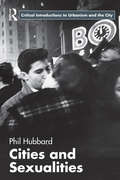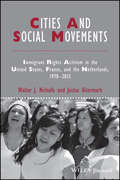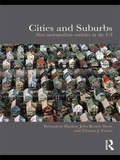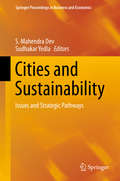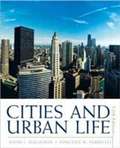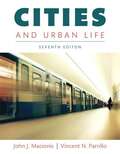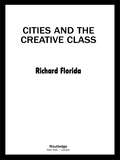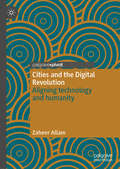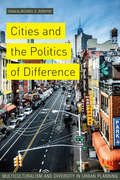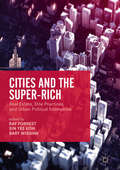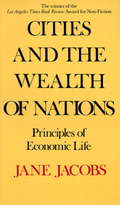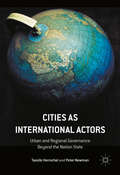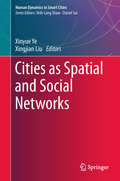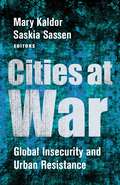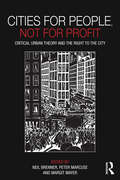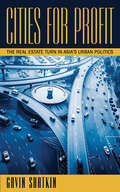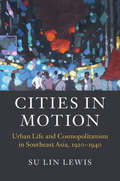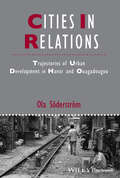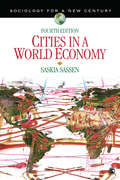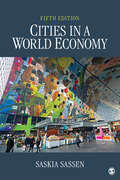- Table View
- List View
Cities and Sexualities (Routledge Critical Introductions to Urbanism and the City)
by Phil HubbardFrom the hotspots of commercial sex through to the suburbia of twitching curtains, urban life and sexualities appear inseparable. Cities are the source of our most familiar images of sexual practice, and are the spaces where new understandings of sexuality take shape. In an era of global business and tourism, cities are also the hubs around which a global sex trade is organised and where virtual sex content is obsessively produced and consumed. Detailing the relationships between sexed bodies, sexual subjectivities and forms of intimacy, Cities and Sexualities explores the role of the city in shaping our sexual lives. At the same time, it describes how the actions of urban governors, city planners, the police and judiciary combine to produce cities in which some sexual proclivities and tastes are normalised and others excluded. In so doing, it maps out the diverse sexual landscapes of the city - from spaces of courtship, coupling and cohabitation through to sites of adult entertainment, prostitution, and pornography. Considering both the normative geographies of heterosexuality and monogamy, as well as urban geographies of radical/queer sex, this book provides a unique perspective on the relationship between sex and the city. Cities and Sexualities offers a wide overview of the state-of-the-art in geographies and sociologies of sexuality, as well as an empirically-grounded account of the forms of desire that animate the erotic city. It describes the diverse sexual landscapes that characterise both the contemporary Western city as well as cities in the global South. The book features a wide range of boxed case studies as well as suggestions for further reading at the end each chapter. It will appeal to undergraduate students studying Geography, Urban Studies, Gender Studies and Sociology.
Cities and Social Change: Encounters with Contemporary Urbanism
by Ronan Paddison Eugene McCann"This textbook of essays by leading critical urbanists is a compelling introduction to an important field of study; it interrogates contemporary conflicts and contradictions inherent in the social experience of living in cities that are undergoing neoliberal restructuring, and grapples with profound questions and challenging policy considerations about diversity, equity, and justice. A stimulant to debate in any undergraduate urban studies classroom, this book will inspire a new generation of urban social scholars." - Alison Bain, York University "Stages a lively encounter with different understandings of urban production and experience, and does so by bringing together an exciting group of scholars working across a diversity of theoretical and geographical contexts. The book focuses on some of the central conceptual and political challenges of contemporary cities, including inequality and poverty, justice and democracy, and everyday life and urban imaginaries, providing a critical platform through which to ask how we might work towards alternative forms of urban living." - Colin McFarlane Durham University What is the city? What is the nature of living in the city? This new textbook provides students with an in-depth understanding of the central issues associated with the city and how living in a city impacts its inhabitants. Theoretically informed and thematically rich, the book is edited by leading scholars in the field and contains an eminent, international cast of contributors and contributions. It provides a critical analysis of the key thinkers, themes and paradigms dealing with the relationship between the built environment and urban life. It includes illustrative case studies, questions for discussion, further reading and web links. Examining the contradictions, conflicts and complexities of city living, the book is an essential resource for students looking to get to grip with the different theoretical and substantive approaches that make up the diverse and rich study of the city and urban life.
Cities and Social Change: Encounters with Contemporary Urbanism
by Ronan Paddison Eugene Mccann"This textbook of essays by leading critical urbanists is a compelling introduction to an important field of study; it interrogates contemporary conflicts and contradictions inherent in the social experience of living in cities that are undergoing neoliberal restructuring, and grapples with profound questions and challenging policy considerations about diversity, equity, and justice. A stimulant to debate in any undergraduate urban studies classroom, this book will inspire a new generation of urban social scholars." - Alison Bain, York University "Stages a lively encounter with different understandings of urban production and experience, and does so by bringing together an exciting group of scholars working across a diversity of theoretical and geographical contexts. The book focuses on some of the central conceptual and political challenges of contemporary cities, including inequality and poverty, justice and democracy, and everyday life and urban imaginaries, providing a critical platform through which to ask how we might work towards alternative forms of urban living." - Colin McFarlane Durham University What is the city? What is the nature of living in the city? This new textbook provides students with an in-depth understanding of the central issues associated with the city and how living in a city impacts its inhabitants. Theoretically informed and thematically rich, the book is edited by leading scholars in the field and contains an eminent, international cast of contributors and contributions. It provides a critical analysis of the key thinkers, themes and paradigms dealing with the relationship between the built environment and urban life. It includes illustrative case studies, questions for discussion, further reading and web links. Examining the contradictions, conflicts and complexities of city living, the book is an essential resource for students looking to get to grip with the different theoretical and substantive approaches that make up the diverse and rich study of the city and urban life.
Cities and Social Movements: Immigrant Rights Activism in the US, France, and the Netherlands, 1970-2015
by Walter J. Nicholls Justus UitermarkThrough historical and comparative research on the immigrant rights movements of the United States, France and the Netherlands, Cities and Social Movements examines how small resistances against restrictive immigration policies do - or don't - develop into large and sustained mobilizations. Presents a comprehensive, comparative analysis of immigrant rights politics in three countries over a period of five decades, providing vivid accounts of the processes through which immigrants activists challenged or confirmed the status quo Theorizes movements from the bottom-up, presenting an urban grassroots account in order to identify how movement networks emerge or fall apart Provides a unique contribution by examining how geography is implicated in the evolution of social movements, discovering how and why the networks constituting movements grow by tracing where they develop Demonstrates how efforts to enforce national borders trigger countless resistances and shows how some environments provide the relational opportunities to nurture these small resistances into sustained mobilizations Written to appeal to a broad audience of students, scholars, policy makers, and activists, without sacrificing theoretical rigor
Cities and Suburbs: New Metropolitan Realities in the US
by John Rennie Short Bernadette Hanlon Thomas J. VicinoThis book is a systematic examination of the historical and current roles that cities and suburbs play in US metropolitan areas. It explores the history of cities and suburbs, their changing dynamics with each other, their growing diversity, the environmental consequences of their development and finally the extent and nature of their decline and renewal. Cities and Suburbs: New Metropolitan Realities in the US offers a comprehensive examination of demographic and socioeconomic processes of US suburbanization by providing a succinct guide to understanding the dynamic relationship between metropolitan structure and processes of social change. A variety of case studies are used in the chapters to explore suburban successes and failures and the discourse concludes with reflections on metropolitan policy and planning for the twenty-first century. The topics of discussion include: Key ideas and concepts on the demographic and sociospatial aspects of metropolitan change The changing nature of city and suburban population migration and their relationships with changes at the local, metropolitan, national, and global levels Current metropolitan public policy issues of large cities and suburbs Links of suburbanization to metropolitan transformation and the growing dichotomy between suburban decline and suburban sprawl in metropolitan areas. Cities and Suburbs relies on theorized case studies, demographic analysis, maps, and photos from North America. Written in a clear and accessible style, the book addresses various fundamental questions about the socioeconomic role that suburbs and cities play in shaping metropolitan areas, their environmental impact, the political consequences, and the resulting policy debates. This is essential reading for scholars and students of Geography, Economics, Politics, Sociology, Urban Studies and Urban Planning.
Cities and Sustainability: Issues and Strategic Pathways (Springer Proceedings in Business and Economics)
by Sudhakar Yedla S. Mahendra DevThe book addresses the sustainability of cities in the context of sustainability science and its application to the city boundary. In doing so it investigates all the components of a city on the basis of sustainability criteria. To achieve sustainability it is essential to adopt an integrated strategy that reflects all sectors within the city boundary and also address the four key normative concepts: the right to develop for all sections, social inclusion, convergence in living standards and shared responsibility and opportunities among sectors and sections. In this book, the individual chapters examine the nodes of sustainability of a city and thus essentially present a large canvas wherein all sustainability-relevant issues are interwoven. This integrative approach is at the heart of the book and offers an extensive, innovative framework for future research on cities and sustainability alike. The book also includes selected case studies that add to the reading and comprehension value of the concepts presented, ensuring a blend of theory and practical case studies to help readers better comprehend the principle of sustainability and its application.
Cities and Urban Life
by John J. Macionis Vincent N. ParrilloDrawing together the work of historians, sociologists, social psychologists, geographers, urban ecologists, anthropologists, political economists, architects, and city planners, this text addresses four key themes: cities and urban life vary according to time and place; cities reflect and intensify society and culture; cities reveal the best and the worst about the human condition; and cities offer the promise (but not always the reality) of a better life. Six case studies offer a broad historical look at major cities in various regions of the world. Annotation c. by Book News, Inc. , Portland, Or.
Cities and Urban Life
by Vincent Parrillo John MacionisFor courses in Urban Sociology A comprehensive overview of classic and contemporary urban sociology. Cities and Urban Life provides an introduction to the study of urban environments around the world. Using an approach that is multidisciplinary but fundamentally sociological, authors John Macionis and Vincent Parrillo help students see how cities have evolved over time, how cities reflect culture, and where the urban story may take us next. The inclusion of the latest data and research references throughout the seventh edition, as well as updated case studies on a variety of cities, ensures that students come away with an up-to-date understanding of contemporary urban life.
Cities and Visitors: Regulating People, Markets, and City Space (IJURR Studies in Urban and Social Change Book Series #57)
by Lily M. HoffmanThe authors of this book use regulation theory to bring theoretical focus and analytic clarity to the study of urban tourism. Provides a unifying analytic framework for the study of urban tourism. Brings urban tourism into focus as an important political, economic and cultural phenomenon. Presents original essays written by established scholars, including studies of Venice, Mexico, Montreal, New York, Los Angeles, London, Barcelona, Berlin, Amsterdam, Paris, and Australia's Gold Coast.
Cities and the Creative Class (Regions And Cities Ser.)
by Richard FloridaIn his compelling follow-up to The Rise of the Creative Class, Richard Florida outlines how certain cities succeed in attracting members of the 'creative class' - the millions of people who work in information-age economic sectors and in industries driven by innovation and talent.
Cities and the Digital Revolution: Aligning technology and humanity
by Zaheer AllamThis book explores the emergence and development of data in cities. It exposes how Information Communication Technology (ICT) corporations seeking to capitalize on cities developing needs for urban technologies have contributed to many of the issues we are faced with today, including urbanization, centralization of wealth and climate change. Using several case studies, the book provides examples of the, in part, detrimental effects ICT driven ‘Smart City’ solutions have had and will have on the human characteristics that contribute to the identity and sense of belonging innate to many of our cities. The rise in Artificial Intelligence, Big Data, and technologies like social media, has changed how people interact with and in cities, and Allam discusses of how these changes require planners, engineers and other urban professionals to adjust their approach. The main question the book seeks to address is ‘how can we use emerging technologies to recalibrate our cities and ensure increased livability, whilst also effectively dealing with their associate challenges?’ This is an ongoing conversation, but one that requires extensive thought as it has extensive consequences. This book will be of interest to students, academics, professionals and policy makers across a broad range of subjects including urban studies, architecture and STS, geography and social policy.
Cities and the Politics of Difference
by Michael BurayidiDemographic change and a growing sensitivity to the diversity of urban communities have increasingly led planners to recognize the necessity of planning for diversity. Edited by Michael A. Burayidi, Cities and the Politics of Difference offers a guide for making diversity a cornerstone of planning practice.The essays in this collection cover the practical and theoretical issues that surround this transformation, discussing ways of planning for inclusive and multicultural cities, enhancing the cultural competence of planners, and expanding the boundaries of planning for multiculturalism to include dimensions of diversity other than ethnicity and religion - including sexual and gender minorities and Indigenous communities. The advice of the contributors on how planners should integrate considerations of diversity in all its forms and guises into practice and theory will be valuable to scholars and practitioners at all levels of government.
Cities and the Super-Rich: Real Estate, Elite Practices and Urban Political Economies (The Contemporary City)
by Sin Yee Koh Ray Forrest Bart WissinkWith the rise of wealth inequalities, our cities are changing dramatically. This collection critically engages with and advances existing debates on the super-rich and their roles in these transformations. An interdisciplinary range of contributions from international experts including sociologists, geographers, historians, discourse analysts, and urban studies specialists reveal crucial aspects of the real estate investment practices of the super-rich, their social spaces in the city as well as the distinct influence of the super-rich on the transformation of four key cities: London, Tokyo, Singapore and Hong Kong. By drawing together diverse disciplines, perspectives, and experiences across different geographical contexts, this book offers a fresh, comparative, and nuanced take on the super-rich and the 1% city, as well as a solid, empirically and theoretically grounded basis to think about future research questions and policy implications.
Cities and the Wealth of Nations
by Jane Jacobs"Learned, iconoclastic and exciting...Jacobs' diagnosis of the decay of cities in an increasingly integrated world economy is on the mark."--New York Times Book Review"Jacobs' book is inspired, idiosyncratic and personal...It is written with verve and humor; for a work of embattled theory, it is wonderfully concrete, and its leaps are breathtaking."--Los Angeles Times"Not only comprehensible but entertaining...Like Mrs. Jacobs' other books, it offers a concrete approach to an abstract and elusive subject. That, all by itself, makes for an intoxicating experience."--New York Times
Cities as International Actors: Urban and Regional Governance Beyond the Nation State
by Peter Newman Tassilo HerrschelThis book explores the growing role of cities and regions as sub-national actors in shaping global governance. Far from being merely carried along by global forces, cities have become active players in making and maintaining the networks and connections that give shape to contemporary globalization. Exploring examples from Europe, North America and beyond, the authors reconcile the two separate, yet complimentary, theoretical and analytical lenses adopted by Urban Studies and International Relations, as they address the nature of 'cities' and 'internationality'. The authors challenge academic debate that is reluctant to cross disciplinary boundaries and thus offer more relevant answers to the new phenomenon of international city action, and how it weakens the traditional prerogative of the state as primary actor in the international realm. Conclusions focus on how this new internationality opens opportunities for cities and regions but also contains potential pitfalls that can constrain policy options and challenge the legitimacy of policy making at all scales.
Cities as Spatial and Social Networks (Human Dynamics in Smart Cities)
by Xinyue Ye Xingjian LiuThis book reports on the latest, cutting-edge scholarship on integrating social network and spatial analyses in the built environment. It sheds light on conceptualization and Implementation of such integration, integration for intra-city level analysis, as well as integration for inter-city level analysis. It explores the use of new data sources concerning human and urban dynamics and provides a discussion of how social network and spatial analyses could be synthesized for a more nuanced understanding of the built environment. As such this book will be a valuable resource for scholars focusing on city-related networks in a number of ‘urban’ disciplines, including but not limited to urban geography, urban informatics, urban planning, urban sociology, and urban studies.
Cities at War: Global Insecurity and Urban Resistance
by Mary Kaldor Sassen SaskiaWarfare in the twenty-first century goes well beyond conventional armies and nation-states. In a world of diffuse conflicts taking place across sprawling cities, war has become fragmented and uneven to match its settings. Yet the analysis of failed states, civil war, and state building rarely considers the city, rather than the country, as the terrain of battle.In Cities at War, Mary Kaldor and Saskia Sassen assemble an international team of scholars to examine cities as sites of contemporary warfare and insecurity. Reflecting Kaldor’s expertise on security cultures and Sassen’s perspective on cities and their geographies, they develop new insight into how cities and their residents encounter instability and conflict, as well as the ways in which urban forms provide possibilities for countering violence. Through a series of case studies of cities including Baghdad, Bogotá, Ciudad Juarez, Kabul, and Karachi, the book reveals the unequal distribution of insecurity as well as how urban capabilities might offer resistance and hope. Through analyses of how contemporary forms of identity, inequality, and segregation interact with the built environment, Cities at War explains why and how political violence has become increasingly urbanized. It also points toward the capacity of the city to shape a different kind of urban subjectivity that can serve as a foundation for a more peaceful and equitable future.
Cities for People, Not for Profit: Critical Urban Theory and the Right to the City
by Peter Marcuse Margit Mayer Neil BrennerThe worldwide financial crisis has sent shock-waves of accelerated economic restructuring, regulatory reorganization and sociopolitical conflict through cities around the world. It has also given new impetus to the struggles of urban social movements emphasizing the injustice, destructiveness and unsustainability of capitalist forms of urbanization. This book contributes analyses intended to be useful for efforts to roll back contemporary profit-based forms of urbanization, and to promote alternative, radically democratic and sustainable forms of urbanism. The contributors provide cutting-edge analyses of contemporary urban restructuring, including the issues of neoliberalization, gentrification, colonization, "creative" cities, architecture and political power, sub-prime mortgage foreclosures and the ongoing struggles of "right to the city" movements. At the same time, the book explores the diverse interpretive frameworks – critical and otherwise – that are currently being used in academic discourse, in political struggles, and in everyday life to decipher contemporary urban transformations and contestations. The slogan, "cities for people, not for profit," sets into stark relief what the contributors view as a central political question involved in efforts, at once theoretical and practical, to address the global urban crises of our time. Drawing upon European and North American scholarship in sociology, politics, geography, urban planning and urban design, the book provides useful insights and perspectives for citizens, activists and intellectuals interested in exploring alternatives to contemporary forms of capitalist urbanization.
Cities for Profit: The Real Estate Turn in Asia’s Urban Politics
by Gavin ShatkinCities for Profit examines the phenomenon of urban real estate megaprojects in Asia—massive, privately built planned urban developments that have captured the imagination of politicians, policymakers, and citizens across the region. These controversial projects, embraced by elites, occasion massive displacement and have extensive social and economic impacts. Gavin Shatkin finds commonalities and similarities in dozens of such projects in Jakarta, Kolkata, and Chongqing. Shatkin is at the vanguard of urban studies in his focus on real estate. Just as cities are increasingly defined and remapped according to the value of the land under their residents’ feet, the lives of city dwellers are shaped and constrained by their ability to keep up with rising costs of urban life. Scholars and policy and planning professionals alike will benefit from Shatkin’s comprehensive research. Cities for Profit contains insights from more than 150 interviews, site visits to projects, and data from government and nongovernmental organization reports and data, urban plans, architectural renderings, annual reports and promotional materials of developers, and newspaper and other media accounts.
Cities in Global Transition: Creating Sustainable Communities in Australia
by Raymond Charles Rauscher Salim MomtazThis book examines the planning of cities in global transition, looking at Australia's Greater Sydney as a case example. The focus is on metropolitan districts (groups of municipalities) within the Greater Sydney region. The subjects of global transition and sustainable urban planning (SUP) are introduced in Chapter 1. How Greater Sydney approaches planning of its region and its districts is then outlined in Chapter 2. In this chapter, three case study districts are selected for critiquing planning in the face of population and new development changes. The districts, beyond the City of Sydney, are: Sydney Inner West, Greater Parramatta and St George. The book further outlines a methodology to assess planning practices within each of the municipalities (twelve case study municipalities in all within the three districts). Included here are State planning principles applying to Greater Sydney, with key principals selected to apply to the case study municipalities and to each district as a unit.
Cities in Globalization: Practices, Policies and Theories (Questioning Cities)
by Peter J. Taylor Ben Derudder Frank Witlox Pieter SaeyDespite traditionally being a strong research topic in urban studies, inter-city relations had become grossly neglected until recently, when it was placed back on the research agenda with the advent of studies of world/global cities. More recently the ‘external relations’ of cities have taken their place alongside ‘internal relations’ within cities to constitute the full nature of cities. This collection of essays on how and why cities are connecting to each other in a globalizing world provides evidence for a new city-centered geography that is emerging in the twenty-first century. Cities in Globalization covers four key themes beginning with the different ways of measuring a ‘world city network’, ranging from analyses of corporate structures to airline passenger flows. Second is the recent European advances in studying ‘urban systems’ which are compared to the Anglo-American city networks approach. These chapters add conceptual vigour to traditional themes and provide findings on European cities in globalization. Thirdly the political implications of these new geographies of flows are considered in a variety of contexts: the localism of city planning, specialist ‘political world cities’, and the ‘war on terror’. Finally, there are a series of chapters that critically review the state of our knowledge on contemporary relations between cities in globalization. Cities in Globalization provides an up-to-date assembly of leading American and European researchers reporting their ideas on the critical issue of how cities are faring in contemporary globalization and is highly illustrated throughout with over forty figures and tables.
Cities in Motion: Urban Life And Cosmopolitanism In Southeast Asia, 1920-1940 (Asian Connections )
by Su Lin LewisIn the 1920s and 1930s, the port-cities of Southeast Asia were staging grounds for diverse groups of ordinary citizens to experiment with modernity, as a rising Japan and American capitalism challenged the predominance of European empires after the First World War. Both migrants and locals played a pivotal role in shaping civic culture. <P><P>Moving away from a nationalist reading of the period, Su Lin Lewis explores layers of cross-cultural interaction in various spheres: the urban built environment, civic associations, print media, education, popular culture and the emergence of the modern woman.<P> While the book focuses on Penang, Rangoon and Bangkok - three cities born amidst British expansion to the region - it explores connected experiences across Asia and in Asian intellectual enclaves in Europe. Cosmopolitan sensibilities were severely tested in the era of post-colonial nationalism, but are undergoing a resurgence in Southeast Asia's civil society and creative class today.<P>Highlights the role of the cosmopolitan port city in Asian modernity.<P> Focuses on the role of neglected communities, such as migrants and modern girls, whose stories are not often told.<P> Provides a reading of cosmopolitanism rooted in Asia rather than in Europe.
Cities in Relations: Trajectories of Urban Development in Hanoi and Ouagadougou (IJURR Studies in Urban and Social Change Book Series)
by Ola SöderströmCities in Relations advances a novel way of thinking about urban transformation by focusing on transnational relations in the least developed countries. Examines the last 20 years of urban development in Hanoi, Vietnam, and in Ouagadougou, Burkina Faso Considers the ways in which a city’s relationships with other places influences its urban development Provides fresh ideas for comparative urban studies that move beyond discussions of economic and policy factors Offers a clear and concise narrative accompanied by more than 45 photos and maps
Cities in a World Economy
by Saskia SassenThe Fourth Edition of Cities in a World Economy shows how certain characteristics of flows of money, information, and people have led to the emergence of a new social formation: global cities, new types of migrations, financial crises, environmental catastrophes, and the multiplication of communication technologies. These developments give new meaning to such fixtures of urban sociology as the centrality of place and the importance of geography in our social world.
Cities in a World Economy
by Saskia SassenCities in a World Economy, Fifth Edition examines the emergence of global cities as a new social formation. As sites of rapid and widespread developments in the areas of finance, information and people, global cities lie at the core of the major processes of globalization. The book reflects the most current data available and explores recent debates such as the role of cities in mitigating environmental problems, the global refugee crisis, Brexit, and the rise of Donald Trump in the United States
